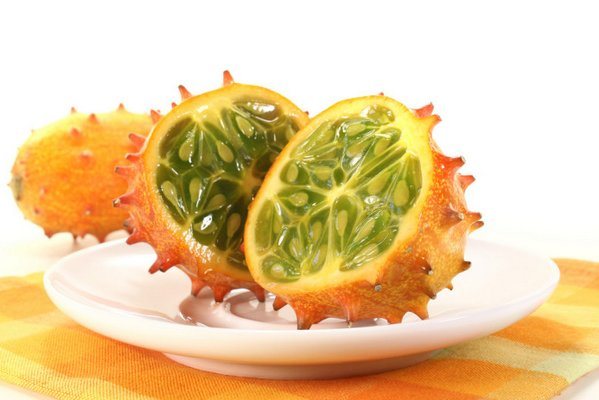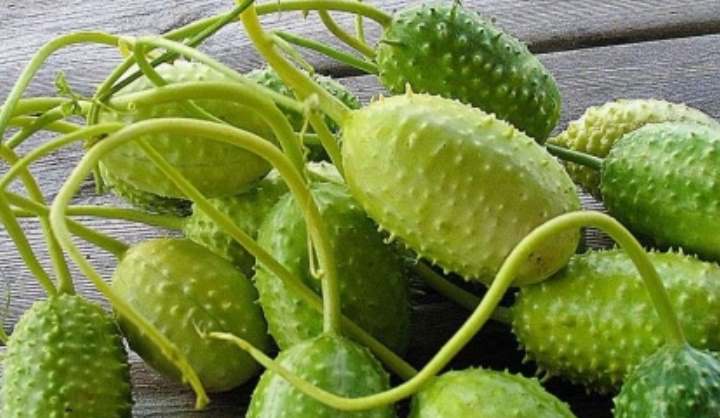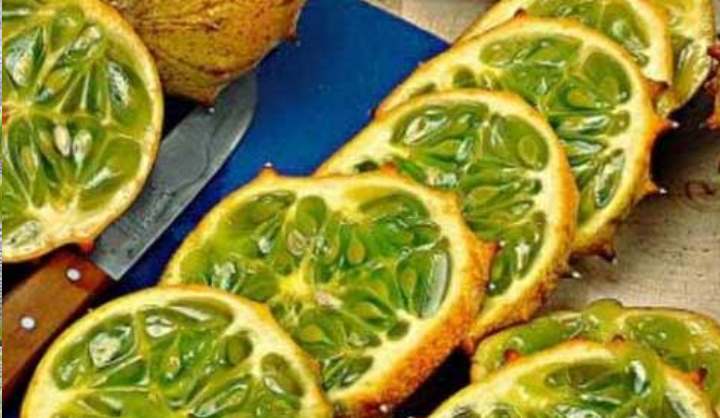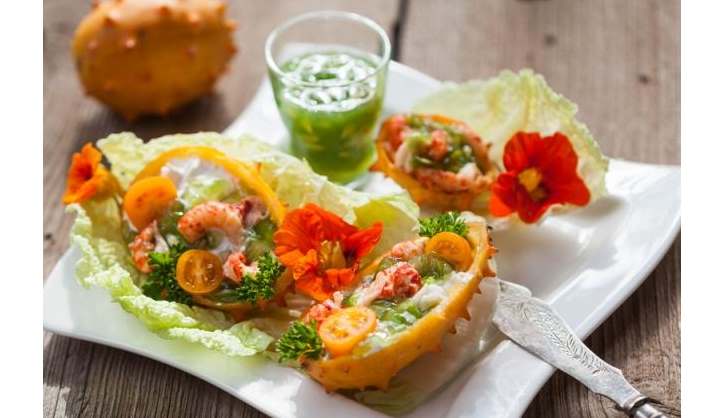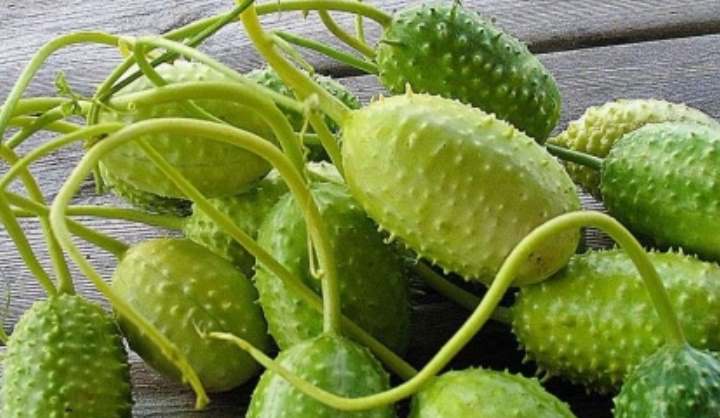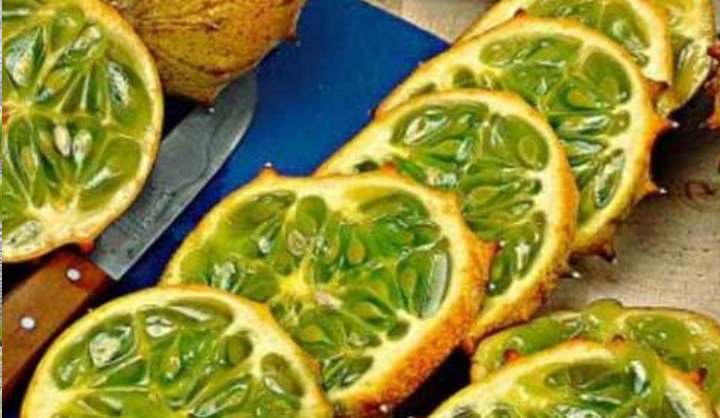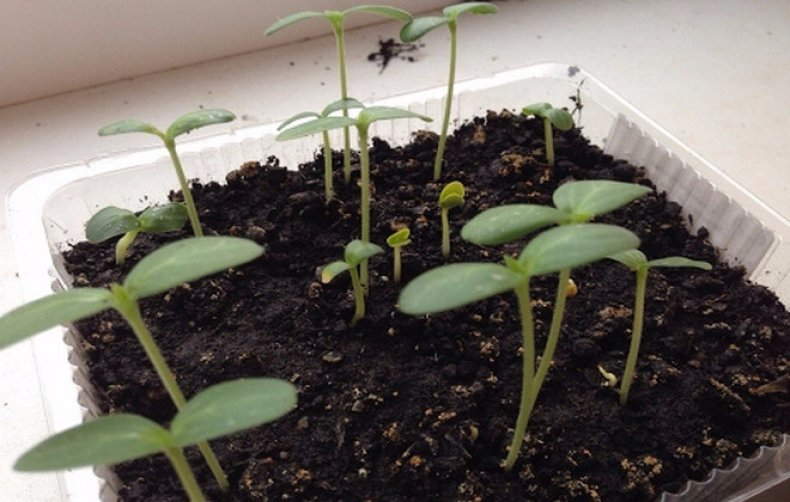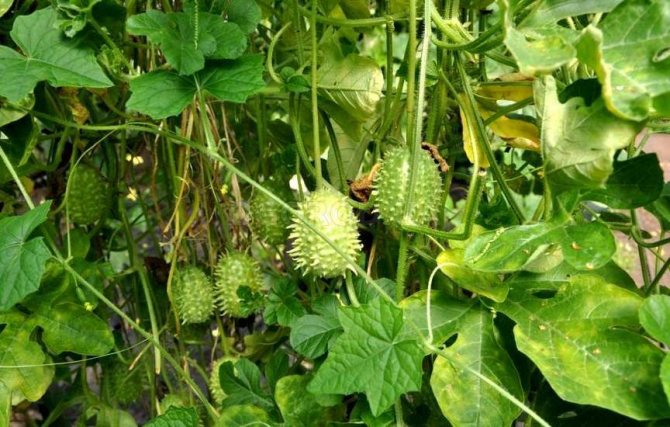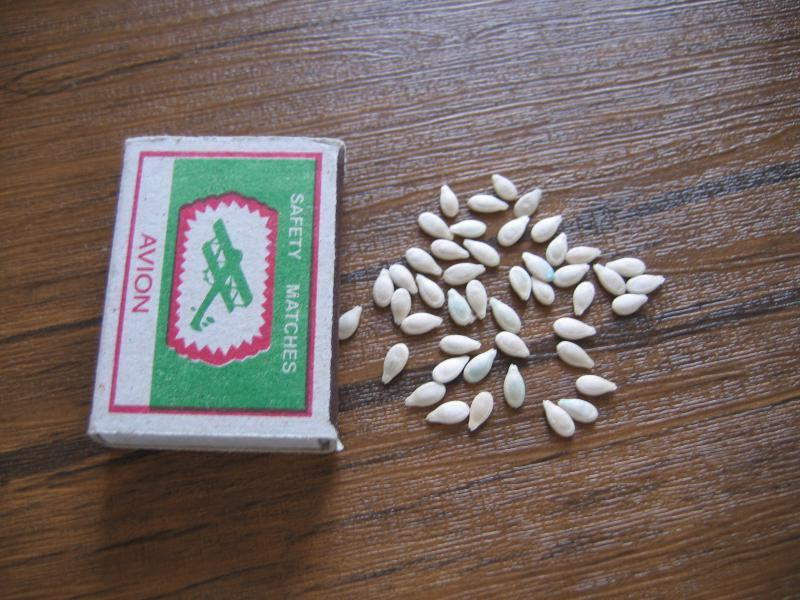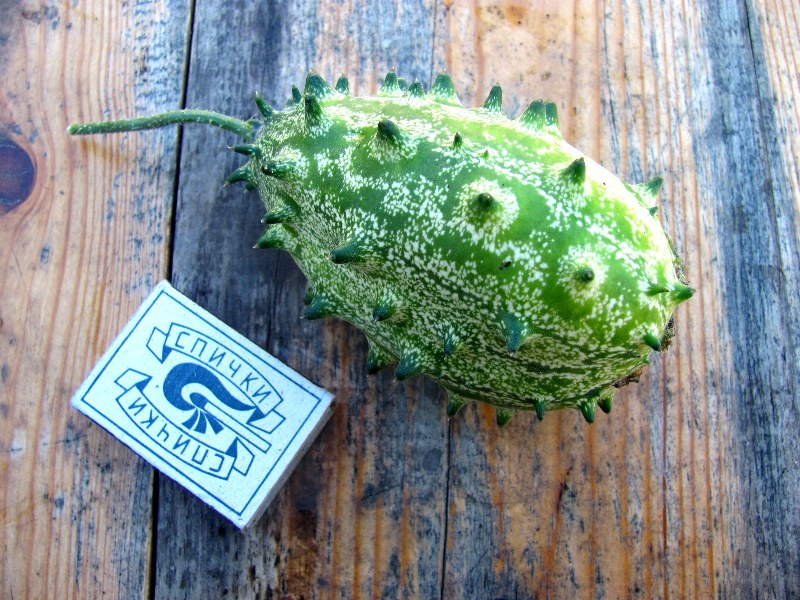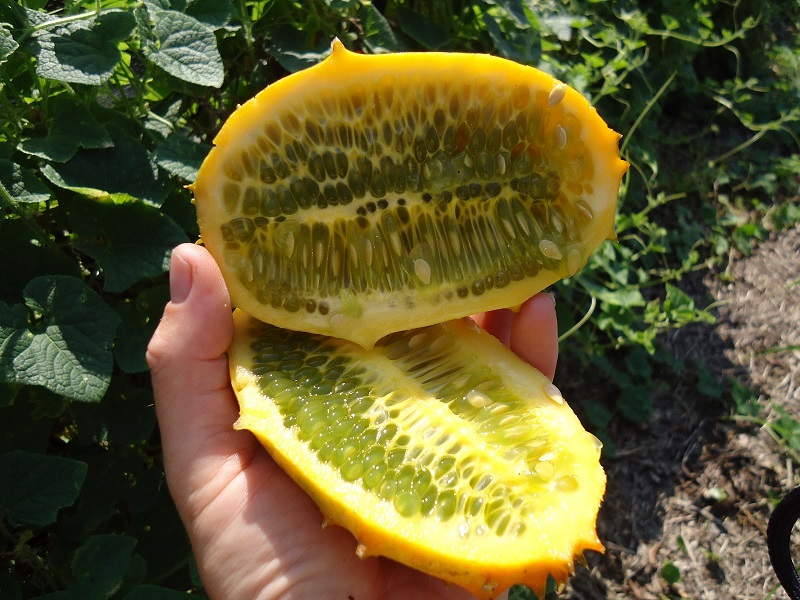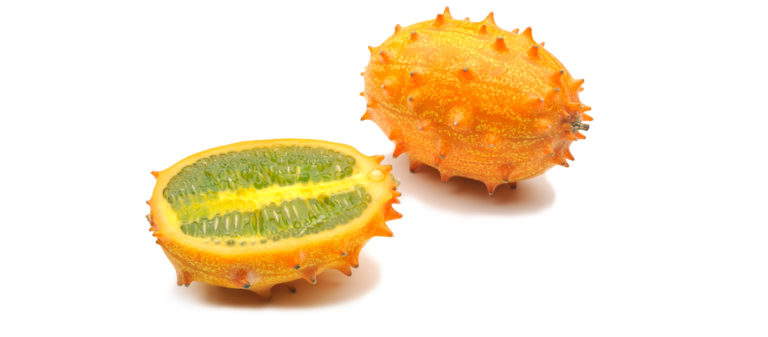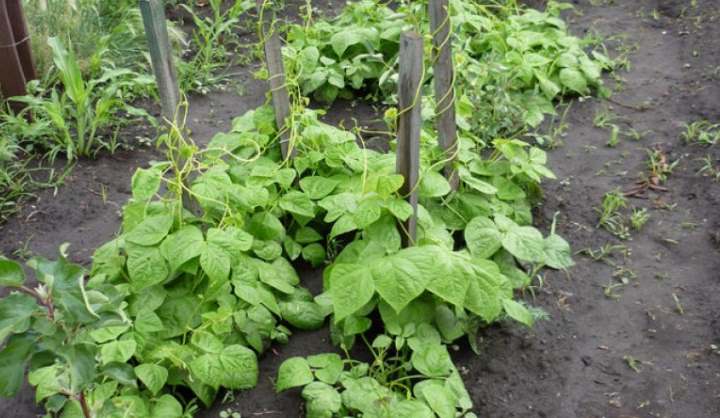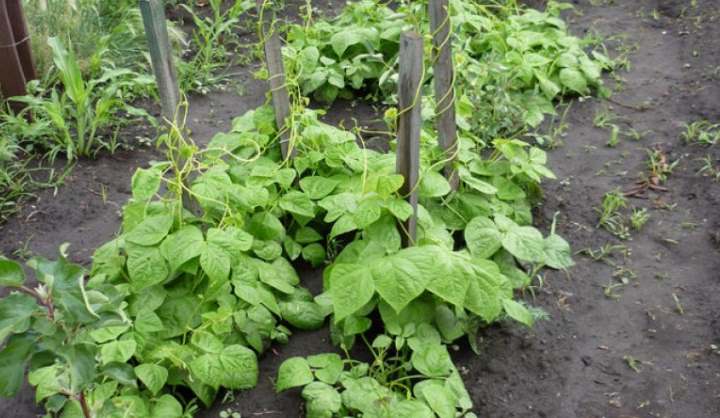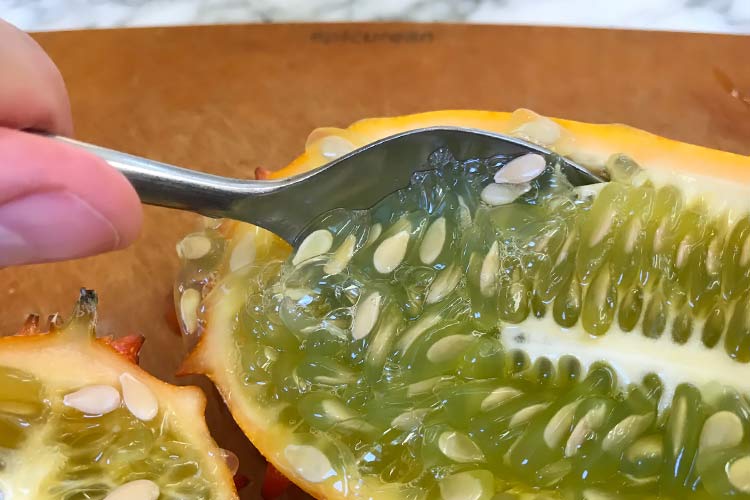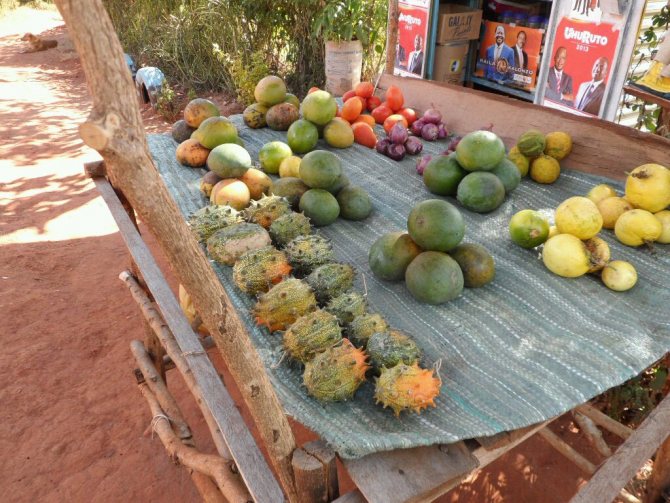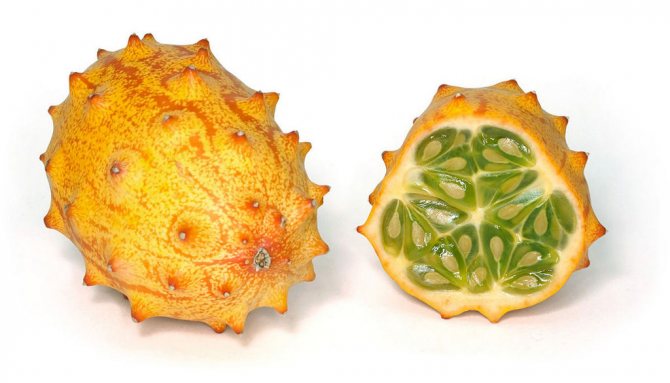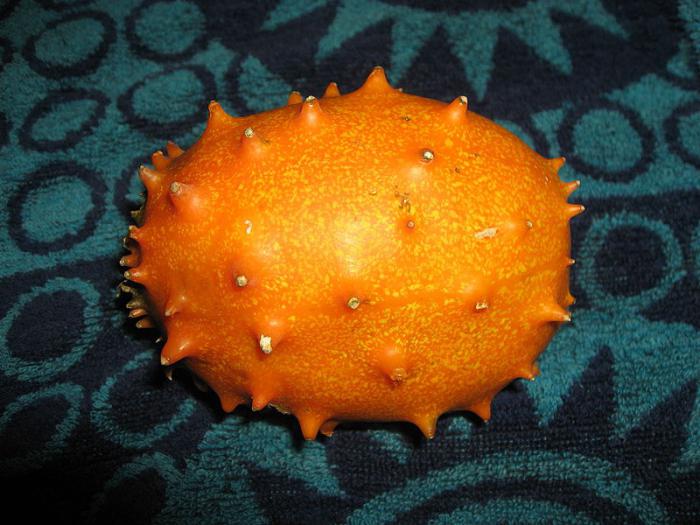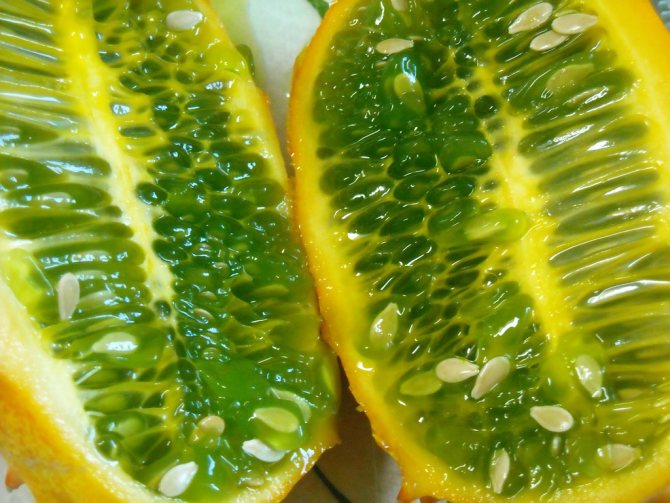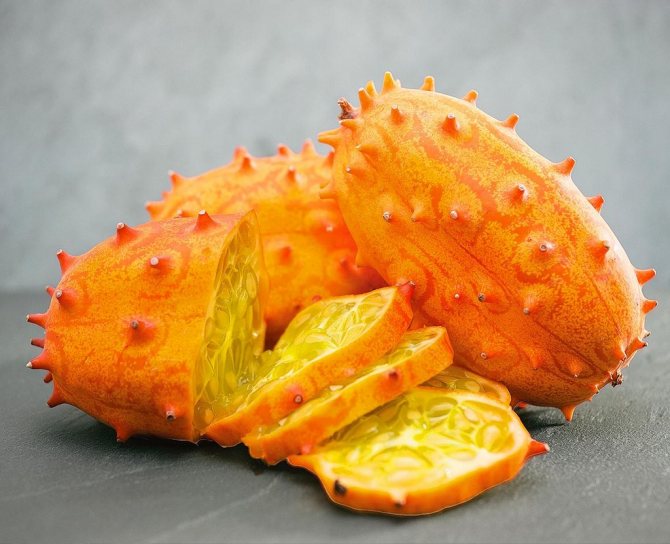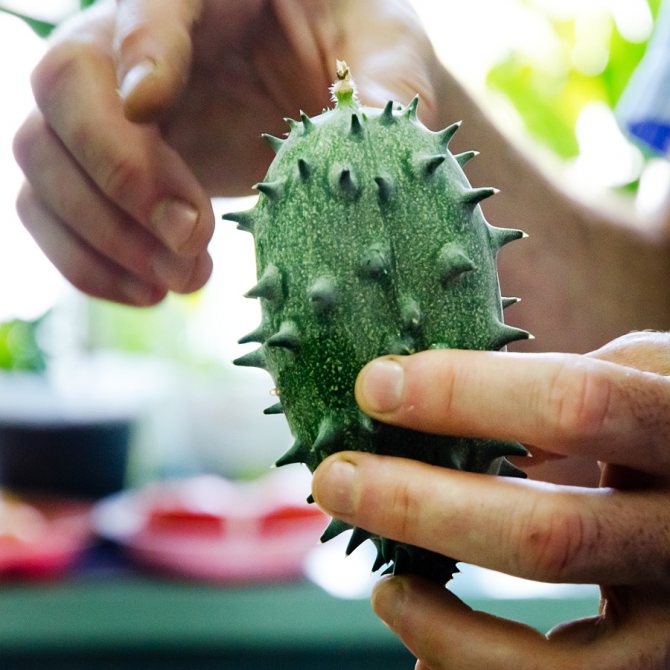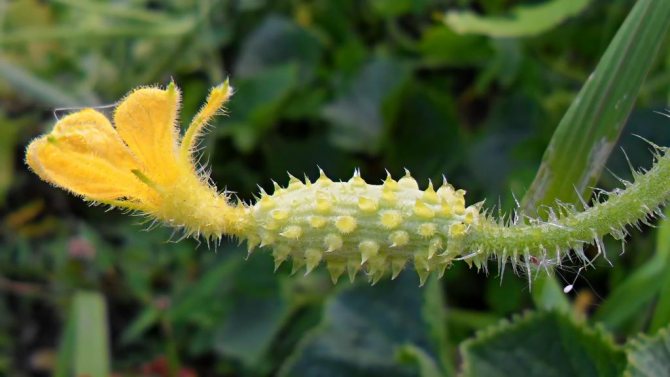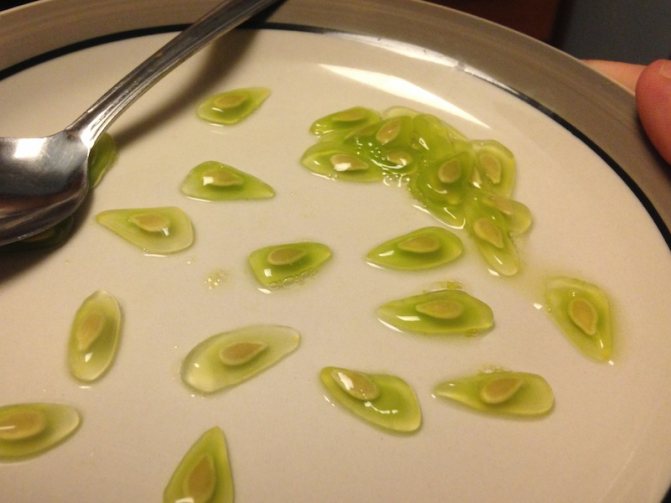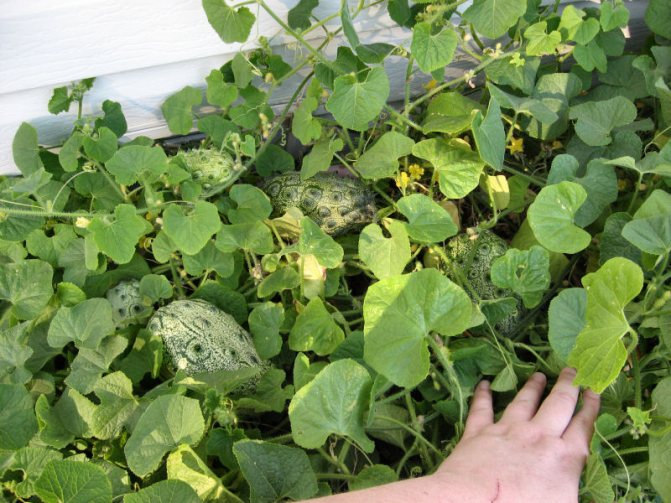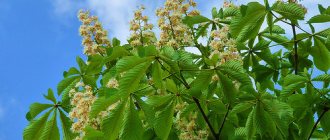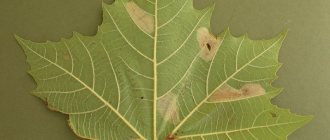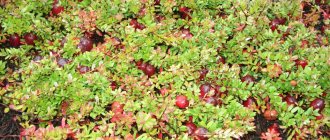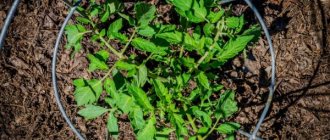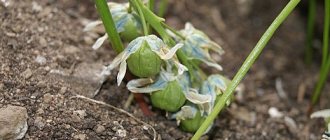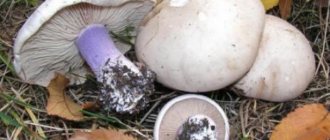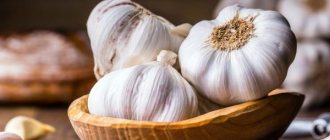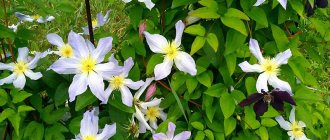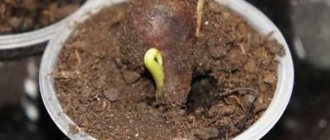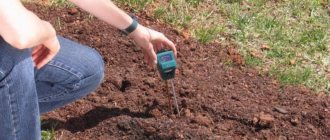Kiwano is an exotic fruit native to Africa. The plant belongs to the herbaceous vines of the Pumpkin family and a species of the genus Cucumber. Externally, the plant with flowers and fruits really look like this vegetable. Liana grows up to 3 meters in length, leaves are large green, poorly dissected. Kiwano bloom begins in the summer, the flowers are yellow, open in the morning until noon. The fruits are oval, similar to a melon or overripe cucumber, only with soft thorns. Inside is a jelly-like green pulp with numerous pale green seeds. Kiwano tastes like a mixture of cucumber and banana. The peel is leathery and sinewy, with soft thorns, green in unripe fruits, gradually, in the process of ripening, acquires a yellow, reddish or orange color. The fruits grow up to 15 cm in length and weigh between 60 and 350 g.
Other names for Kiwano: milano, false anguria, Antillean or African cucumber, jelly or horned melon. Today this plant is widely grown in Central America, Israel, USA and New Zealand.
Kiwano grows successfully in countries with a tropical climate and does not tolerate sub-zero temperatures at all. Russian breeders have bred the Green Dragon variety, which is distinguished by its good adaptability to the climate of Russia and quickly begins to bear fruit. Already 75 days after the emergence of sprouts, the first crop can be harvested.

Benefit and harm
Kiwano contains many vitamins, A, C, groups P and B, ascorbic acid, beta-carotene, carbohydrates, proteins and fats, iron, manganese, potassium, calcium, phosphorus, zinc, copper, salts and organic acids. One fruit contains 89% water, 100 g of kiwano contains 45 kcal.
Kiwano health benefits:
- lowers blood pressure, which is necessary for hypertension. Regular consumption of the fruit protects against myocardial infarction and rheumatism;
- reduces the amount of sugar in the blood, which is especially important for people with diabetes;
- thins the blood, due to the large amount of water in the pulp;
- removes radionuclides, slags and toxins from the body;
- restores the balance of water and salt, saturating the cells of the body with the necessary substances, oxygen and moisture;
- prevents aging of the body and the formation of cancerous tumors;
- stimulates digestion, thanks to dietary fibers, which are part of the fruit and envelop the walls of the stomach and intestines, contributing to their regeneration;
- useful for losing weight, saturates the body with important elements for it and promotes the breakdown of fats;
- strengthens the immune system and joints;
- increases hemoglobin in the blood, increasing the number of red blood cells;
- helps with insomnia, for this juice is mixed with honey and drunk at night.
The fruits have the following properties:
- calming
- antiseptic
- anti-inflammatory
- cleansing
- immunomodulatory
- healing
In cosmetology, masks are made from the fruit, which tighten and tone the skin of the face and body, make scrubs and peels.
There are no contraindications to the use of the fetus, except for an allergic reaction of the body. It should be remembered that for us this is an exotic fruit and for the body it is a new food that needs to be tasted a little and monitored for the reaction.


Mask for the face
Remove the pulp from 1 Kiwano fruit and stir with honey. You can use yogurt or sour cream.Apply the prepared mixture on your face for a few minutes, then rinse with warm water.
Application in medicine
Fruit juice is used as a sedative, it is very useful to drink it for people suffering from insomnia. The fruit has a beneficial effect on intestinal motility, is used externally in the treatment of burns and open wounds, and helps to stop bleeding. Kiwano has a therapeutic effect on anemia, tuberculosis, atherosclerosis, bronchitis and gout. With chemotherapy, fruit juice is very useful, which helps to some extent protect the body from the side effect of this procedure - hair loss.
Cooking applications
Kiwano is eaten raw, salads are prepared from it, which are seasoned with lemon juice, pepper and salt. Fruit is added to ice cream, sorbet, curd desserts. Young fruits are pickled and canned like cucumbers. Kiwano is suitable for cooking cereals, soups and side dishes.
The fruit goes well with yoghurts, creams, milkshakes, berries, vegetables, fish and meat dishes. Sauces, preserves, compotes and desserts are delicious from kiwano. The fruits can be cooked and pickled. The juice of the fruit is mixed with orange and lemon, whipped in a mixer and served in a glass from the skin of the fruit. In the homeland of this fruit, the most popular dish is a seafood appetizer with cheese and kiwano.
The interesting appearance of the fruit is used to decorate dishes and festive tables. When serving, the fruit can be cut into slices or slices, put the pulp in a glass of skin, decorating with berries.


Sherbet with Kiwano
Ingredients:
- 3 oranges;
- 2 tbsp. l. cherry liqueur;
- 150 g pineapple yogurt;
- 180 g of condensed milk or cream;
- 3 Kiwano fruits.
Preparation:
- Squeeze the juice from the oranges and strain, add liqueur, yogurt and condensed milk.
- Put the mass overnight in a cool place, covered with gauze folded in 3 layers.
- Add the kiwano pulp, stir and place in the freezer for a day.
- For the first 2-3 hours, beat the mixture with a mixer or a whisk so that no lumps form in the sorbet.
- Put the finished dessert in glasses, garnish with cream, berries or fruits.
Kiwano sauce
Ingredients:
- 2 limes;
- 1 kiwano;
- 1 lemon;
- a clove of garlic;
- salt pepper;
- 1 tsp mustard;
- 1.5 tbsp. l. olive. oils.
Preparation:
- Peel the limes, kiwano and lemon.
- Grind the fruits in a meat grinder and squeeze the mass through cheesecloth.
- Add salt and pepper to taste, crushed garlic, oil and mustard to the juice, mix well.
- Bring the mass to a boil and place in the freezer for a while.
The sauce gives dishes an exotic flavor and aroma, use it as a marinade or serve with meat and fish.


General information about the plant
Kiwano is native to tropical Africa. According to scientific classification, the plant belongs to the Pumpkin family and the Cucumber genus. Its closest relatives, in addition to cucumber, are melon, cantaloupe, anguria and about 50 species of exotic tropical plants.
Modern cultivars have been bred from wild Kiwano, which, thanks to the original shape of the fruit and unusual taste, are actively grown in Central America, Israel and New Zealand.
Many who have seen this amazing fruit in a store cannot immediately understand: is Kiwano a vegetable or a fruit? In this case, it is impossible to answer this question unambiguously.
How to choose and eat Kiwano
When choosing exotic fruits, you must be very careful not to buy spoiled or unripe. When choosing a Kiwano, remember the following guidelines:
- buy medium-sized fruits;
- ripe fruits of rich orange color with marble blotches;
- there should be no dark brown spots and damage on the peel;
- the fruit should be elastic to the touch;
- the mature fruit has yellow thorns.
If the Kiwano did not have time to ripen and you purchased a green fruit, do not worry, it will ripen on its own in a few days.
If this is your first time trying these fruits, you will have a question, how to eat them? Kiwano peel is inedible, it is often used as a plate on which the pulp is spread. The flesh of the fruit is very tender and cannot be separated from the peel like an orange. Usually the fruit is cut in two and the contents are eaten with a spoon. You can add sugar or salt to the pulp to taste.
What varieties of Kiwano can be grown on a personal plot
The growing area of Kiwano is very extensive, therefore, depending on certain climatic conditions, different varieties are cultivated on different continents. Domestic breeders also bred the Kiwano variety, which is maximally adapted to the conditions of our climate. This is a Kiwano variety called the Green Dragon. The variety belongs to the group of annual dioecious plants with a short growing season, that is, 75-77 days pass from the moment the first shoots appear until the fruits are fully ripe. The stems are creeping, with a maximum length of 3 meters. The foliage of the plant is green, slightly dissected. Kiwano fruit of the Green Dragon variety has an oval shape with tubercles. At first, the color of the fruit is light green, as soon as the plant reaches maturity, the color changes to bright yellow. The average weight of a ripe fruit is 150 grams, shelf life is 6 months.
Growing at home
If you have a ripe Kiwano fruit in your hands, you can save the seeds and plant them in late April or early May. A plant can take root well in an apartment and in a garden if it is planted correctly and the necessary conditions are created. It is necessary to extract the seeds only from a well-ripened fruit. Choose large and whole seeds.
Planting Kiwano seeds consists of several stages:
- soak the seeds in a sodium humate solution, you can use the Epina-extra fertilizer;
- when the seeds are swollen, put them in a warm place for 3 days until they hatch, this will increase the chance of germination;
- Plant the seeds 3.5 cm deep in loose, nutritious soil available from your flower shop. The planting container should be no more than 10 cm in diameter;
- cover the pot with foil, when the seeds sprout, it must be removed. Water the sprouts regularly.


Care and transplant in open ground
During cultivation, you must follow some rules for caring for the plant:
- keep the temperature at 25 degrees;
- provide the plant with long daylight hours using fluorescent lamps;
- protect the kiwano from direct sunlight to avoid burns;
- keep the soil moist and loosen regularly.
After 4 weeks, the Kiwano can be transplanted into the open ground. To protect a young plant from the cold, you can create a greenhouse for it. The plant needs a lot of space because it grows and spreads quickly. It is preferable to plant it along fences or walls on a flat surface, in a calm, warm place. No more than 2 bushes should be planted per m2. The planting hole should be 40 x 35 cm in size. The root system of the Kiwano is poorly developed and located superficially, does not withstand drought and stagnant water. A great advantage is the plant's good resistance to disease pests.
Watering the plant is carried out 2-3 times a week, if the weather is not very hot. If it is very hot, water every day. It is advisable to do this before sunrise or after sunset. There should be no weeds in the area where Kiwano grows, weed the soil regularly. When the ground is crusty, soil it early in the morning or in the evening.


If the soil is overheated or overcooled during the day, carry out hilling.This will protect the roots from hypothermia and overheating, and will help retain moisture in the ground. For a good harvest, be sure to pinch by removing side shoots. The bushes are formed in a circle or allowed to stretch out in one continuous line.
Be sure to fertilize the soil, apply mineral and organic fertilizing, so that the Kiwano grows faster and gains the required amount of green mass. From organic, an infusion of chicken manure, mullein or grass is suitable. From mineral it is better to use complex fertilizers. You need to fertilize every 10 days, alternating mineral and organic fertilizers so that the plant does not starve.
If the kiwano has support, tie the main stem vertically so that the bulk grows upward, this will help save space around. You can use a cucumber net. When grown in a greenhouse, you cannot do without a garter, otherwise the plant will creep very much. Kiwano makes a very beautiful hedge, decorated with bright fruits.


Choosing a place
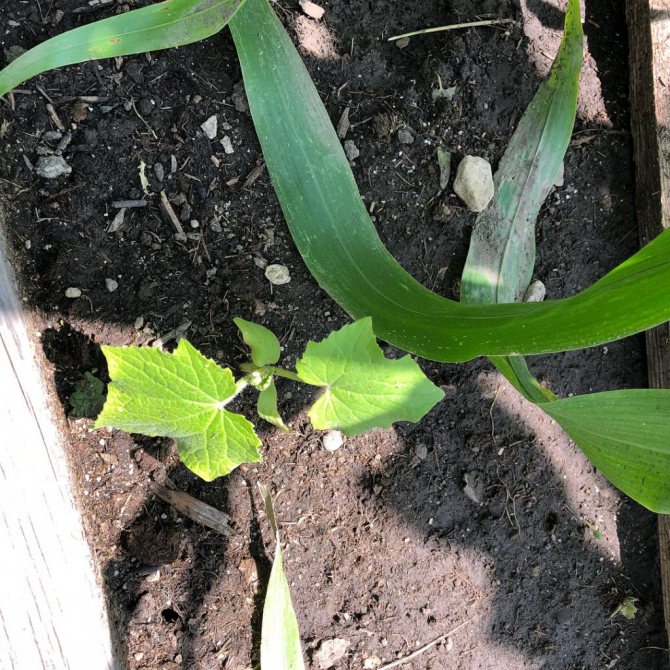

Growing Kiwano from seeds is not as difficult as it seems, but you still need to be guided by generally accepted rules that allow you to achieve a good harvest:
- The plant is light-loving, but it is afraid of direct sunlight. Under the crowns of shrubs and trees, kiwano will develop slowly, it will take more energy to develop greenery, since it is very good in the shade! But we need a crop, not a plentiful green mass, so open, windless areas shaded with a fence are a priority (it can even be a simple fence made of a chain-link mesh).
- To have a larger harvest, and it was not difficult for you to collect it, put supports, as for cucumbers.
- Kiwano does not tolerate cramped conditions, it develops quickly and spreads, plant it only on a large area, without the proximity of other plants.
Plants must be planted at least 40 cm apart from each other. Usually kiwano is planted so that no more than two bushes are located on one square meter.
Harvesting and storage
Kiwano is harvested in August, when the fruits turn yellow. These fruits keep well, but they leave much to be desired in taste. If you want a tasty harvest, start harvesting when the Kiwano is bright orange in color. After harvesting, the plant bears more fruit. With the right harvest, one Kiwano growing in a greenhouse can harvest up to 200 fruits per season. In order to have a good harvest, it is necessary to remove the grown greens in time and immediately pinch the liana in order to limit the growth of shoots with male flowers.
The crop is stored for up to 6 months, while it does not need to be frozen or placed in the refrigerator. If you want to stock up on fruits for the winter, you can preserve them with salt or sugar. Such preparations will benefit the body in cold weather, saturate with useful substances and decorate the table for the holidays.
What is this fruit
Kiwano is also called horned melon or African cucumber. This exotic fruit is of particular interest due to its unusual shape. The fruits are orange-shaped, weighing about 300 g and 10 cm long, rich orange color with soft formations all over the surface.
The plant is a liana, which has a large number of lashes, like a simple cucumber, only with smaller leaves.
In its homeland of Africa, horned melon grows as a fruit, and in America and southern Europe, it is grown as a vegetable crop. African cucumber is an unpretentious plant, does not suffer from diseases and pests, and gives good yields. It has one drawback - it reacts negatively to a decrease in temperature.
Did you know? Kiwano is called the African cucumber because of the green jelly pulp with light soft seeds, like a cucumber. The seeds are edible.
And the name "horned melon" comes from a bright orange dense rind with thorns all over the surface.
